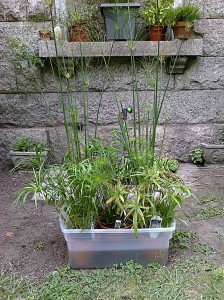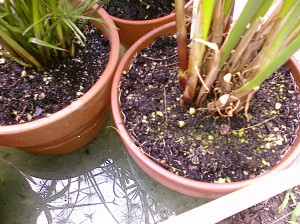In college, I knew a woman named Wendy Martin who owned a local business, Rooftop Futons. In her high-ceilinged 2nd-floor south-facing office, she had a magnificent pot of giant papyrus growing, at least 6′ tall, the image of which has stuck in my head ever since. I can’t be certain, but I’m reasonably sure her plant was an “Umbrella palm”, Cyperus alternifolius. Now that I have my own ridiculously-high ceilings (16′!), I’ve bought a few papyrus plants to try my own hand at.

After an afternoon spent trolling garden centers and nurseries with my amazing gardening friend Kent Russell, actually ended up with five plants. In addition to a pair of great Cyperus papyrus “Giganteus”, I now have three smaller varieties: Cyperus involucratus “Baby Tut”, Cyperus albostriatus “Variegatus”, and Cyperus isocladus.
Being late in the season, I bought them all root-bound in 4″ pots. I re-potted into 6″ clay pots with a good gunky potting soil, with a little fish meal worked in for good measure. I aggressively cut back any stressed stems. All five pots were then placed in a large plastic tote, which was filled with water up to within an inch of the tops of the clay pots. I top up the water every three days or so, dosing once with a teaspoon of 15-30-15 fertilizer.
Growth in just the last two weeks has been fantastic! The C. papyrus and C. involucratus have been putting new stems up at about 1″/day. The C. papyrus is showing crazy root development, already snaking little white rootlets around and over the edges of the pot. The C. isocladus isn’t so much growing up as it is growing out. The poorest of the bunch is the C. albostriatus; It was well into seed when I bought it, so it may just be a phase. The existing growth seems stagnant, but there are quite a few new shoots starting out!

I had at first envisioned an indoor water garden, in a large tub or ideally a small cast-iron slipper-style bathtub. Researching more thoroughly, I see that these plants would do best with summers outside, so I’m trying out more portable ideas. Also, the small varietals really seem to want to spread out; they might share space with the very vertical C. papyrus, but don’t play as well with companions of their own stature. I think I’ll leave them in standard clay pots, which I will in turn submerge inside sealed larger pots, preferably something nicely-glazed. The bathtub idea might still happen, but probably as a strictly outdoor feature.
I’m not exactly sure why I find these so fascinating. There is something neat about these primitive old-world sedges, that can look like both grasses and palms, with leaf-like flowers and flower-like leaves. And of course, the attraction of a plant that is practically impossible to over-water!
-

I happen to have the same obsession for Cyperus too, not all but Cyperus Haspan, which I have always problem keeping them nice looking during winter. And I have always wanted to try out growing Cyperus Papyrus, which is also quite challenging to keep over winter I have heard. And finally I have got one from ebay, growing from seed as described. Now, what I really want to say is that you would probably love the look and the vibe of Equisetum japonicum as well, also you might like a clump of green with babyblue flowers of water-forgetmenot. They both require similar care to Cyperus, but can be kept outside over winter.


2 comments
Comments feed for this article